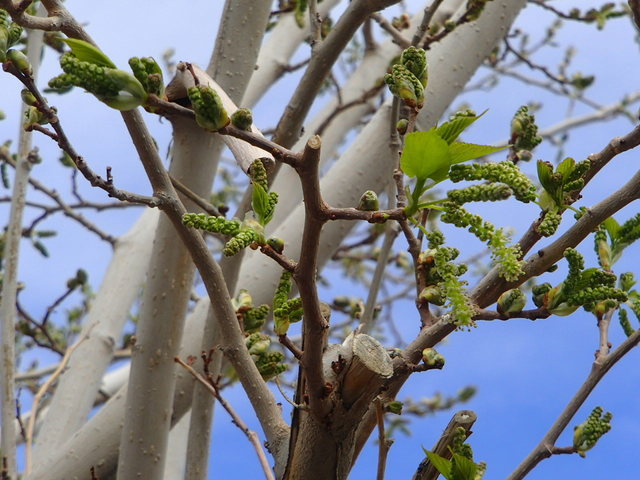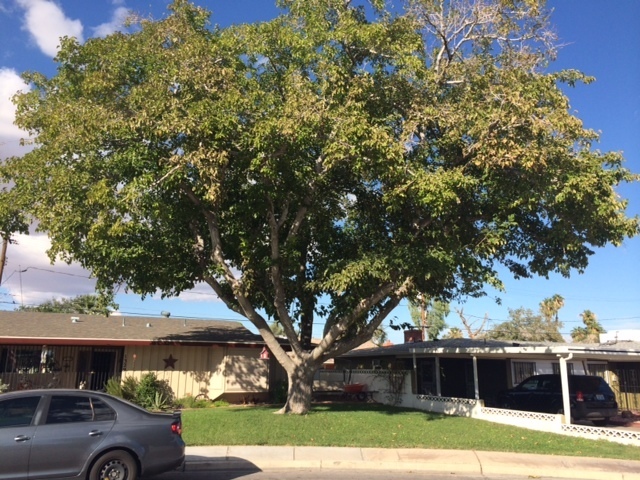Be careful where planting because many desert trees have invasive root systems
Q: I would like to replace a huge mulberry tree in my front yard; roots are very invasive, but the shade is wonderful. We have a west-facing home. I would like to replace it with a small bay laurel for cooking purposes and a shoestring acacia for shade. Are these trees invasive, and would both be too much?
A: Invasive has several meanings. If you mean the roots, then, yes, mulberry has a very invasive root system. Mulberry is a great tree for the desert, if you are just talking about how easily it handles extremes of all kinds and produces 100 percent shade when it gets enough water.
But it does have a lot of problems, including very high water use. The male tree produces a lot of pollen that can be a human health hazard, and the roots will get into any place where there is water and nutrients.
But that goes for almost every tree, including many of our desert trees, such as acacia and mesquite. If given the chance, bay laurel will have an invasive root system.
You will want to keep all trees added a distance from the house and other structures, including walls, that is half of its mature height. Never plant them on top of a septic system, near a swimming pool or near sewer lines.
I think planting bay laurel in a western exposure could be a mistake. It will do much better on the north or east side of a home with some protection from the late-afternoon sun. As a warning to you, I have seen freeze damage to bay laurel in the Las Vegas Valley.
I would try to put it in a spot that has some protection from strong winter winds. The acacia will handle a western exposure very nicely. However, it will not give you the same shade as a mulberry. I think you could classify the acacia as filtered sunlight, which will allow you to plant beneath it. Planting under a mulberry tree has many more restrictions because of the dense shade.
Q: A month ago, we had a shrub that was seemingly healthy. It began losing its leaves since then. I do not know the name of this shrub, but it is 10 years old and planted on the north side of our home, getting only the early morning sun. My question is, is there a possibility of the leaves coming back, or is this shrub a goner?
A: I couldn’t tell 100 percent from the picture you sent, but I think it is a pittosporum. First glance at the picture looked like it went through some sort of rapid shock. That’s why there is leaf drop, and many of them are still green. Otherwise, the plant looks healthy.
I think the soil got too dry for a short time and caused the leaf drop. Take a hose and soak the area at the base of the shrub twice during this next week. I think you will see it produce new leaves and start to come back within seven to 10 days.
Check to make sure the drip emitters are not plugged, and the plant is getting water. But I think it was a short-term water problem during excessively hot weather.
Q: We have two Chinese pistache trees in our backyard that appear to have verticillium wilt. Any suggestions?
A: How did you confirm this disease? Do you have isolated branches that are dying back?
It is rather rare to have this disease in a home landscape. Not impossible, but rare. If you are correct, this will affect your future landscape and plant selection for many years to come.
There is not much that you can do if your trees have verticillium wilt. It is fairly easy to diagnose if you know what to look for.
All you can do now is make sure the trees are not getting too much water and not fertilized with too much nitrogen, and you can prune out the infected limbs.
This disease is in the soil, so planting in this spot with susceptible woody trees is not a good idea. You can use ornamental grasses and pines in this spot, since they don’t get this disease.
Q: There is a brown patch in my fescue lawn. Is it caused by bugs or fungus, and ,if so, how do I eradicate? I had a similar problem this past summer.
A: This looks like summer patch disease, which is common on tall fescue here starting about June, during the heat. Notice how the edge of the dead spot is well-defined. It appears the attack is over, but now you are left with dead spots.
Mark your calendar when it generally pops up. Usually this is at the time of summer monsoons when the humidity increases.
Apply a fungicide for lawns that says it controls summer patch at this time. Fungicides mostly are preventive in nature. They help curb the spread of disease but often do not correct the problem.
You will protect the lawn with a fungicide until this summer monsoon season is over. Wait until Oct. 1, and then rake up the dead areas and mow the lawn short in that area.
Spread a good-quality fescue seed, top dress it lightly with topdressing and water lightly daily until it germinates. The topdressing could be steer manure or even sand. You just want a light cover over the seed so it doesn’t dry out too quickly and to try to hide it from the pigeons. Once it germinates, reduce watering gradually until you are back to your normal irrigation cycle.
Fertilizing your lawn using compost instead of granular fertilizers can have a big impact on future disease problems. You might consider using compost instead of a mineral fertilizer. You will have to apply it three or four times during the year if you expect to control lawn diseases.
Q: Last year I had many beautiful lemons for the first time on a 3- to 4-year-old Meyer dwarf tree. After all the lemons were picked in the late winter, I pruned the tree. This spring, there were no flowers or buds, and we have only one lemon on the tree. What can I do now to ensure a good crop next year?
A: The problem you face pruning your lemon right after harvest is that it is ready to start blooming the next month. Pruning it after harvest can interfere with the next crop.
Typically, you will harvest Meyer lemon in December, and they will start blooming in January and February. This means they are already “thinking of” flowering when you are harvesting.
Also, if you cut them back too hard, they will put their energy into new growth rather than flowering. On top of that, if you give them a high nitrogen fertilizer after you prune them in January, then you can make the situation worse by forcing new growth at the expense of flower production.
This is one reason we say that citrus does not require much pruning. When you do prune, you will remove broken branches, crossing branches, unhealthy growth, and maybe remove a branch or two entirely to open up the canopy for more light if they are too dense.
This next year, be more careful with your pruning and remove only selective branches that are causing problems and hope we don’t get a late freeze that kills all the flowers, potential flowers and young fruit.
Bob Morris is a horticulture expert living in Las Vegas and professor emeritus for the University of Nevada. Visit his blog at xtremehorticulture.blogspot.com. Send questions to Extremehort@aol.com.


















